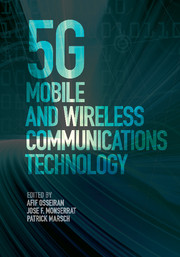Book contents
- Frontmatter
- Dedication
- Contents
- List of contributors
- Foreword
- Acknowledgments
- Acronyms
- 1 Introduction
- 2 5G use cases and system concept
- 3 The 5G architecture
- 4 Machine-type communications
- 5 Device-to-device (D2D) communications
- 6 Millimeter wave communications
- 7 The 5G radio-access technologies
- 8 Massive multiple-input multiple-output (MIMO) systems
- 9 Coordinated multi-point transmission in 5G
- 10 Relaying and wireless network coding
- 11 Interference management, mobility management, and dynamic reconfiguration
- 12 Spectrum
- 13 The 5G wireless propagation channel models
- 14 Simulation methodology
- Index
- References
14 - Simulation methodology
Published online by Cambridge University Press: 05 June 2016
- Frontmatter
- Dedication
- Contents
- List of contributors
- Foreword
- Acknowledgments
- Acronyms
- 1 Introduction
- 2 5G use cases and system concept
- 3 The 5G architecture
- 4 Machine-type communications
- 5 Device-to-device (D2D) communications
- 6 Millimeter wave communications
- 7 The 5G radio-access technologies
- 8 Massive multiple-input multiple-output (MIMO) systems
- 9 Coordinated multi-point transmission in 5G
- 10 Relaying and wireless network coding
- 11 Interference management, mobility management, and dynamic reconfiguration
- 12 Spectrum
- 13 The 5G wireless propagation channel models
- 14 Simulation methodology
- Index
- References
Summary
A simulation methodology is needed in the 5G technical work in order to ensure consistency of results obtained, by means of a computer simulation. This methodology must comprise a procedure for calibrating the simulator, guidelines for evaluating, and a mechanism supporting and controlling the validity of the performed simulations. This chapter provides a methodology for simulation to align assumptions. The alignment allows for a direct comparison of different 5G technology components. The chapter is based on the experience of the authors in the simulation work performed in the framework of the International Mobile Telecommunications-Advanced (IMT-Advanced) definition and in METIS [1]. Finally, some relevant test cases and preferred models are introduced.
Evaluation methodology
In this section, methodology guidelines are given to enable consistent performance evaluations. The guidelines may serve as a framework with aligned assumptions, consistent choice of models and simulation reference metrics to ensure that the results can be compared. The results on different levels are not meant to be compared but to be used as possible input, e.g. link-level simulations can be used as input to system-level simulations but should not be compared to them. Below, the main performance indicators, as well as suitable channel and propagation models, are explained and defined. The main characteristics of the evaluation scenarios are out of the scope of this chapter, since they are thoroughly described in Chapter 2.
Performance indicators
The main performance indicators to be used in the evaluation of the 5G system are defined and explained hereafter. It should be noted that the material (of the performance indicators) is based on [1]–[4].
User throughput
The user throughput is defined as the total amount of received information bits at the receiver divided by the total active session time at the data link layer [2][3]. Active session time does not include the waiting time at the application layer, e.g. reading time for web-browsing, or back-off time introduced by TCP/IP's traffic control, and therefore it is, in general, different from the session length.
A second definition of the user throughput accounts for the whole session time, instead of only the active session time. Both definitions are equivalent for full buffer traffic model, which does not have neither reading nor back-off times.
- Type
- Chapter
- Information
- 5G Mobile and Wireless Communications Technology , pp. 381 - 400Publisher: Cambridge University PressPrint publication year: 2016



